Yamaha XL700 Manual
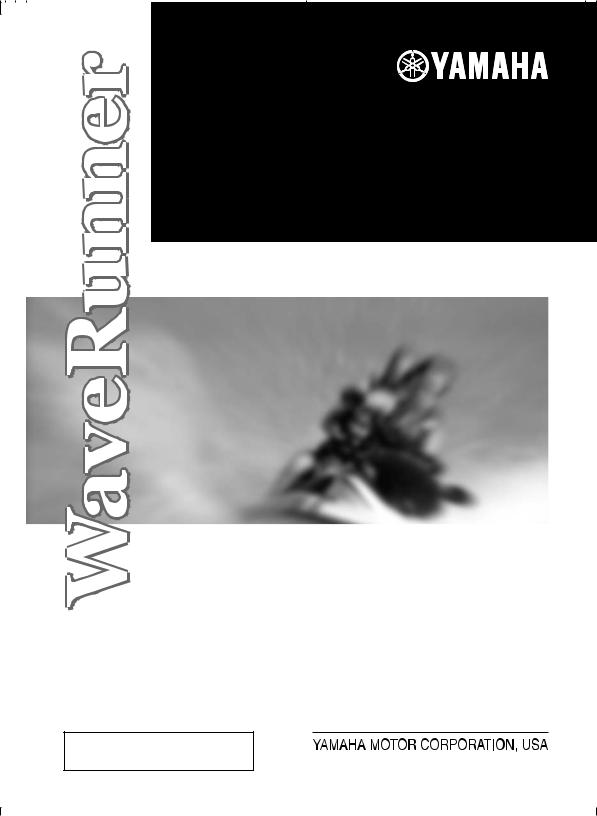
OWNER’S/OPERATOR’S MANUAL
READ THIS MANUAL
CAREFULLY BEFORE OPERATION!
U.S.A. Edition
LIT-18626-04-03
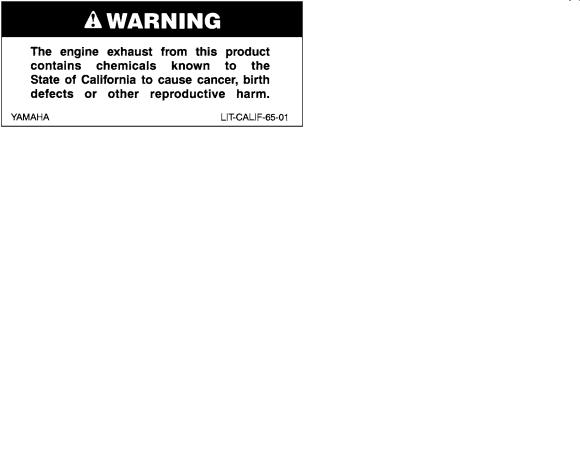
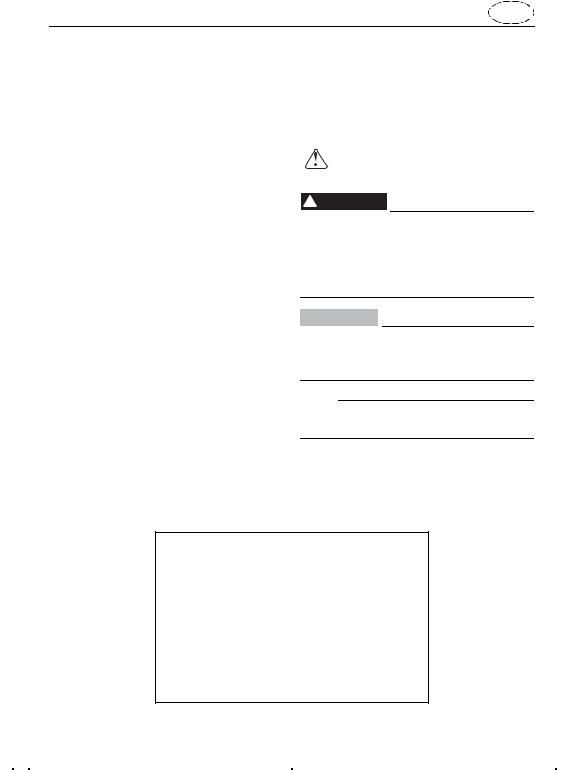
E
EJU00270
To the owner/operator
Thank you for choosing a Yamaha watercraft.
This Owner’s/Operator’s Manual contains information you will need for proper operation, maintenance, and care. A thorough understanding of these simple instructions will help you to obtain maximum enjoyment from your new Yamaha. If you have any questions about the operation or maintenance of your watercraft, please consult a Yamaha dealer.
Because Yamaha has a policy of continuing product improvement, this product may not be exactly as described in this Owner’s/ Operator’s Manual. Specifications are subject to change without notice.
This manual should be considered a permanent part of this watercraft and should remain with it even if the watercraft is subsequently sold.
Important manual information:
In this manual, information of particular importance is distinguished in the following ways:
The Safety Alert Symbol means ATTENTION! BECOME ALERT! YOUR SAFETY IS INVOLVED!
 WARNING
WARNING
Failure to follow WARNING instructions could result in severe injury or death to the machine operator, passenger(s), a bystander, or a person inspecting or repairing the watercraft.
CAUTION:
A CAUTION indicates special precautions that must be taken to avoid damage to the watercraft.
NOTE:
A NOTE provides key information to make procedures easier or clearer.
EJU00271a
WaveRunner XL700
OWNER’S/OPERATOR’S MANUAL ©2000 by Yamaha Motor Corporation, USA 1st Edition, July 2000
All rights reserved.
Any reprinting or unauthorized use without the written permission of Yamaha Motor Corporation, USA is expressly prohibited.
Printed in USA
P/N LIT-18626-04-03

EJU00273 |
CONTENTS |
E |
|
||
|
|
GENERAL AND SAFETY
INFORMATION
FEATURE AND FUNCTIONS
OPERATION
MAINTENANCE AND CARE
TROUBLESHOOTING AND
EMERGENCY PROCEDURES
APPENDIX
READ THIS OWNER’S/OPERATOR’S MANUAL CAREFULLY
BEFORE OPERATING YOUR WATERCRAFT.
1
2
3
4
5
6

|
|
|
E |
|
|
|
|
EJU00274 |
|
|
|
|
GENERAL AND |
|
|
|
|
SAFETY |
1 |
|
|
|
INFORMATION |
|
|
|
|
Identification numbers............................. |
1-1 |
|
|
|
Primary Identification (PRI-ID) number.. |
1-1 |
|
|
|
Hull Identification Number (HIN)............. |
1-1 |
|
|
|
Engine serial number.............................. |
1-1 |
|
|
|
Emission control information................. |
1-2 |
|
|
|
Approval label of Emission control |
|
|
|
|
certificate................................................. |
1-2 |
|
|
|
Manufactured date label......................... |
1-2 |
|
|
|
Important labels........................................ |
1-3 |
|
|
|
Label location.......................................... |
1-3 |
|
|
|
Warning labels ........................................ |
1-4 |
|
|
|
Caution labels ......................................... |
1-6 |
|
|
|
Other labels............................................. |
1-7 |
|
|
|
Safety information.............................. |
1-8 |
|
|
|
Limitations on who may operate the |
|
|
|
|
watercraft................................................. |
1-8 |
|
|
|
Cruising limitations.................................. |
1-9 |
|
|
|
Operation requirements........................ |
1-10 |
|
|
|
Hazard information ............................... |
1-13 |
|
|
|
Watercraft characteristics..................... |
1-13 |
|
|
|
Water-skiing .......................................... |
1-14 |
|
|
|
Rules of the Road................................... |
1-16 |
|
|
|
Steering and sailing rules ..................... |
1-16 |
|
|
|
Rules when encountering vessels ....... |
1-17 |
|
|
|
Other special situations ........................ |
1-18 |
|
|
|
Reading buoys and other markers....... |
1-18 |
|
|
|
To get more boating safety |
|
|
|
|
information.............................................. |
1-20 |
|
|
|
United States Coast Guard .................. |
1-20 |
|
|
|
Other sources ....................................... |
1-20 |
|
|
|
Watercraft Education and Training....... |
1-20 |
|
|
|
Enjoy your watercraft responsibly....... |
1-21 |
|
|
|
|
|

E
EJU00699
Identification numbers
Record your Primary Identification (PRIID) number, Hull Identification Number (HIN) and engine serial number in the spaces provided, to assist you in ordering spare parts from a Yamaha dealer. Also record and keep these ID numbers in a separate place in case your watercraft is stolen.
EJU00700
Primary Identification (PRI-ID) number
The PRI-ID number is stamped on a label 1 attached to the inside of the engine compartment.
EJU00701
Hull Identification Number (HIN)
The HIN is stamped on a plate 2 attached to the aft deck.
EJU00288a
Engine serial number
The engine serial number is stamped on a label 3 attached to the engine unit.
1-1
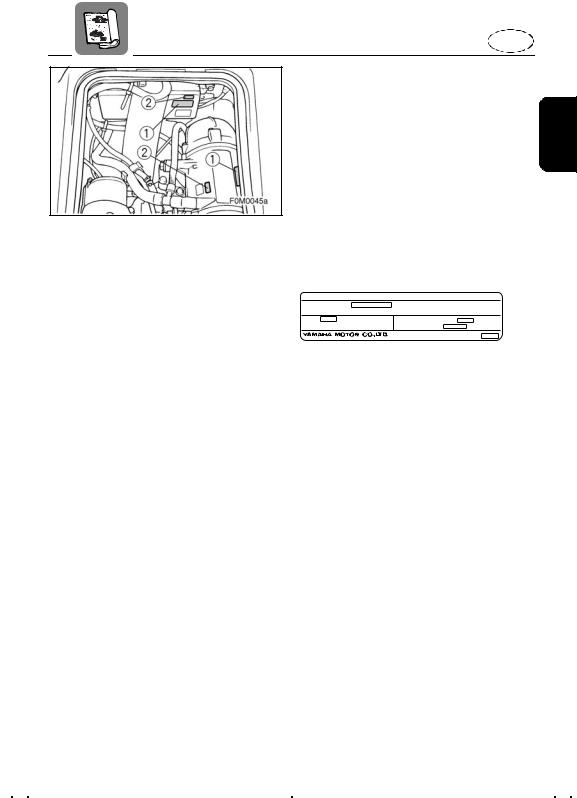
E
EJU00631a
Emission control information
This engine conforms to the U.S. Environmental Protection Agency (EPA) regulations for marine SI engines for the year 2001.
Approval label of Emission control certificate
This label is attached to the electrical box and muffler.
1 Emission control information label
EMISSION CONTROL INFORMATION
ENGINE FAMILY :
THIS ENGINE CONFORMS TO 2001 U.S. EPA REGULATIONS FOR MARINE SI ENGINES.
FELs : |
g/kw-hr |
SPARK PLUG GAP (mm) : |
|
|
|
TROLLING SPEED : |
rpm |
Manufactured date label
This label is attached to the electrical box and muffler.
2 Manufactured date label
1-2
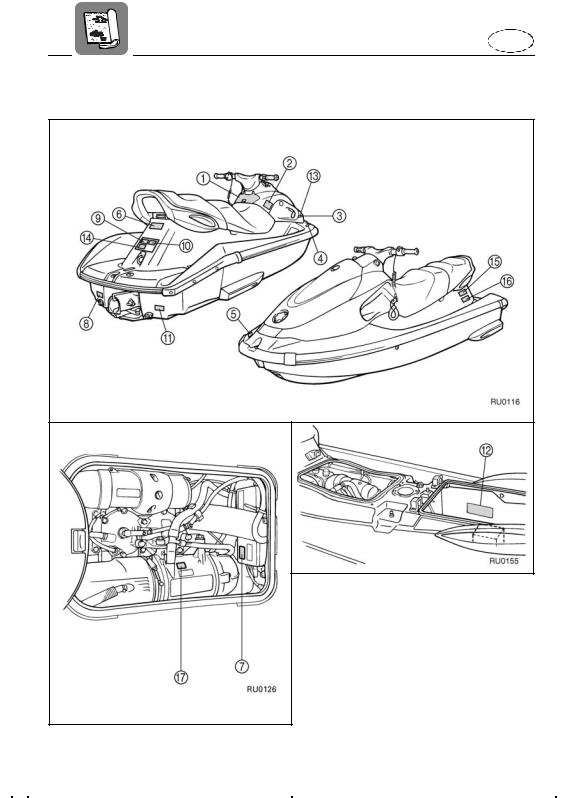
E
EJU00293
Important labels
Label location
1-3
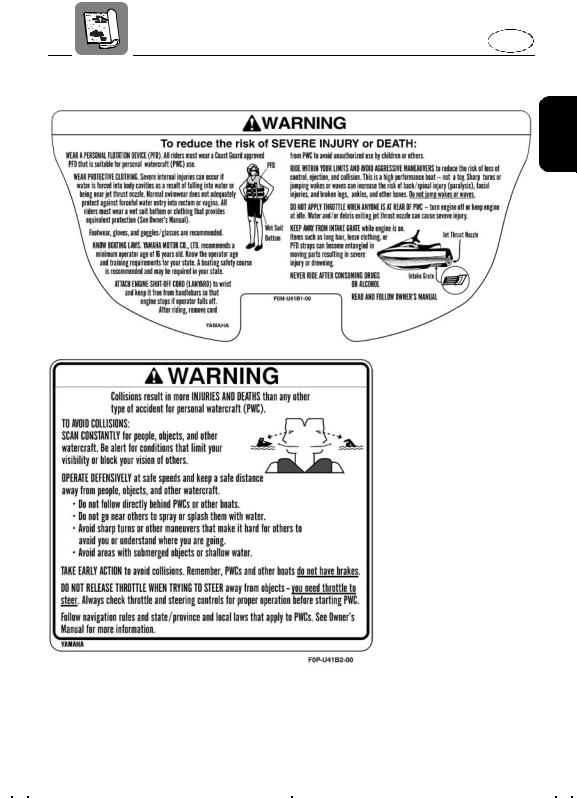
E
Warning labels
1
2
1-4

E
3 |
4 |
5 |
6 |
7
8
1-5

E
Caution labels
9 |
0 |
A
B
1-6

E
Other labels
C D
E F
G
1-7
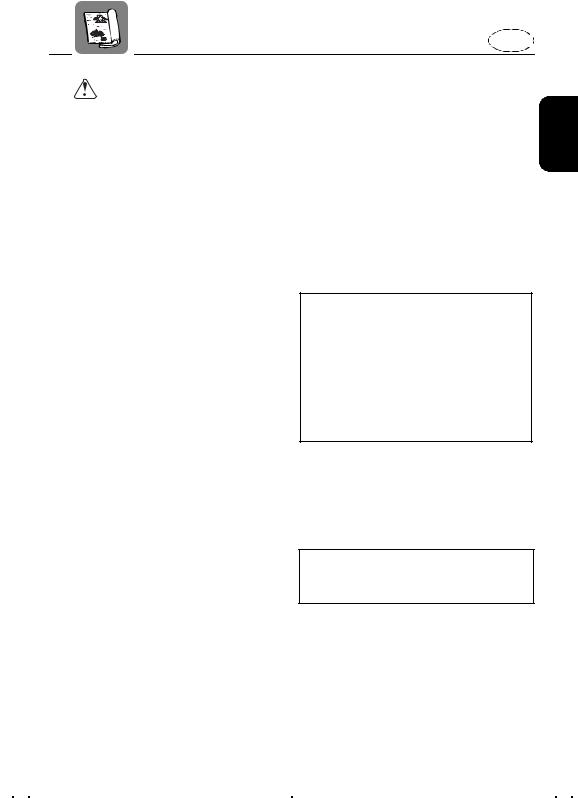
E
EJU00686 |
EJU00667a |
Safety information |
Limitations on who may |
|
operate the watercraft |
The safe use and operation of this watercraft is dependent upon the use of proper riding techniques, as well as upon the common sense, good judgment, and expertise of the operator.
Every operator should know the following requirements before riding the watercraft.
●Before operating the watercraft, read the Owner’s/Operator’s Manual, the Riding Practice Guide, the Riding Instruction card and all warning and caution labels on the watercraft. Also, watch the Basic Orientation Video provided with your watercraft. These materials should give you an understanding of the watercraft and its operation.
●Never allow anyone to operate this watercraft until they too have read the Owner’s/ Operator’s Manual, the Riding Practice Guide, the Riding Instruction card and all warning and caution labels, and if possible watched the Basic Orientation Video.
Showing them the video may help reinforce the information contained in these materials.
●Yamaha recommends a minimum operator age of 16 years old.
Adults must supervise use by minors. Know the operator age and training requirements for your state. A boating safety course is recommended and may be required in your state. You can find local rules by contacting the United States Coast Guard (USCG), the National Association of State Boating Law Administrators, or your local Power Squadron.
●This watercraft is designed to carry the operator and up to 2 passengers. Never exceed the maximum load limit or allow more than 3 persons (or 2 persons if a water-skier is being pulled) to ride the watercraft at one time.
Maximum load: 240 kg (530 lb)
Load is the total weight of cargo, operator and passengers.
●Do not operate the watercraft with any passengers on board until you have considerable practice and experience riding alone. Operating the watercraft with passengers requires more skill. Take the time to become accustomed to the handling characteristics of the watercraft before trying any difficult maneuvers.
1-8
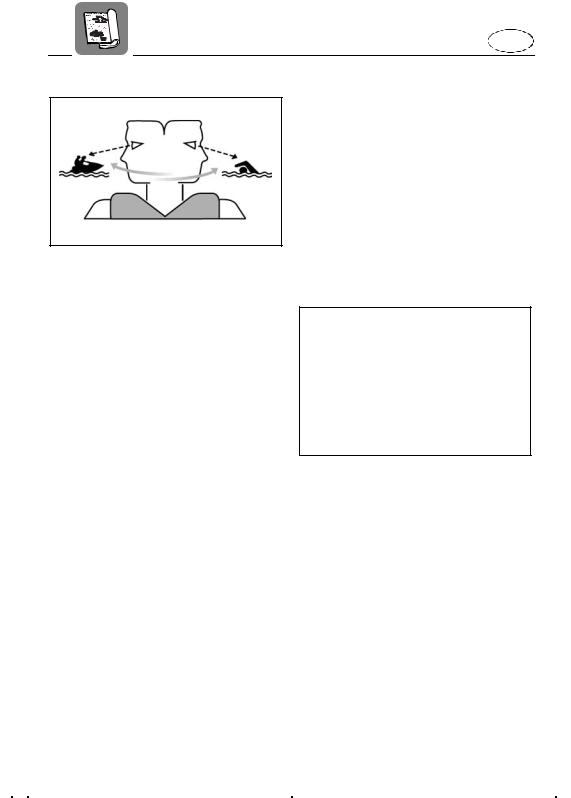
E
EJU00613
Cruising limitations
●Scan constantly for people, objects, and other watercraft. Be alert for conditions that limit your visibility or block your vision of others.
●Operate defensively at safe speeds and keep a safe distance away from people, objects, and other watercraft.
●Do not follow directly behind watercraft or other boats.
●Do not go near others to spray or splash them with water.
●Avoid sharp turns or other maneuvers that make it hard for others to avoid you or understand where you are going.
●Avoid areas with submerged objects or shallow water.
●Ride within your limits and avoid aggressive maneuvers to reduce the risk of loss of control, ejection, and collision.
●This is a high performance boat—not a toy. Sharp turns or jumping wakes or waves can increase the risk of back/spinal injury (paralysis), facial injuries, and broken legs, ankles and other bones. Do not jump wakes or waves.
●Do not operate the watercraft in rough water, bad weather or when visibility is poor; this may lead to an accident causing injury or death. Be alert to the possibility of adverse weather. Take note of weather forecasts and the prevailing weather conditions before setting out on your watercraft.
●As with any water sport, you should not ride your watercraft without someone else near by. If you ride further than swimming distance from shore, you should ride by another boat or watercraft, but make sure you stay a safe distance away. It’s good common sense!
●Never operate in water that is less than 60 cm (2 ft) deep, otherwise you increase your chance of hitting a submerged object, which could result in injury.
1-9
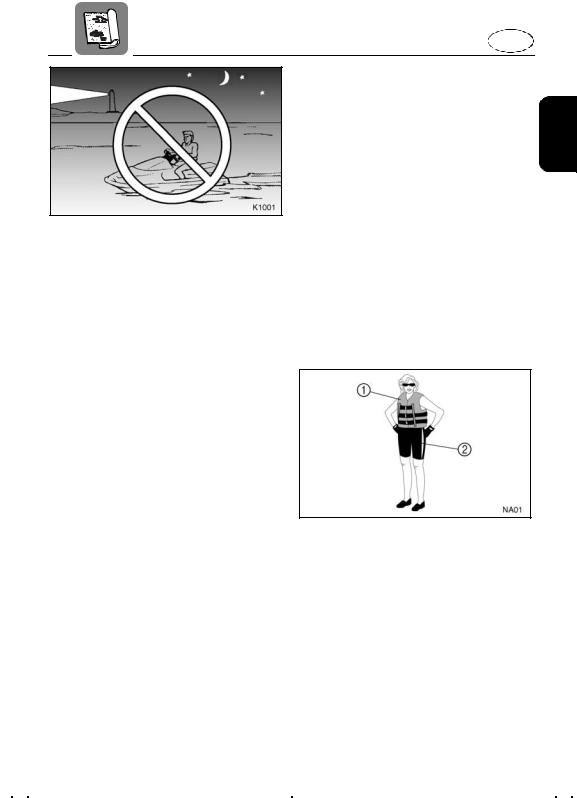
E
●This watercraft is not equipped with lighting required for night operation. Do not operate the watercraft after sunset or before dawn, otherwise you increase the risk of colliding with another boat, which could result in severe injury or death.
EJU00735a
Operation requirements
●All riders must wear a Coast Guard approved personal flotation device (PFD) that is suitable for personal watercraft use.
●Wear protective clothing. Severe internal injuries can occur if water is forced into body cavities as a result of falling into water or being near the jet thrust nozzle.
Normal swimwear does not adequately protect against forceful water entry into rectum or vagina. All riders must wear a wetsuit bottom or clothing that provides equivalent protection. Such clothing includes thick, tightly woven, sturdy and snug-fitting apparel such as denim, but does not include spandex or similar fabrics, like those used in bicycle shorts.
1 Coast Guard approved PFD
2 Wetsuit bottom
●Eye protection is recommended to keep wind, water, and glare from the sun out of your eyes while you operate your watercraft. Restraining straps for eyewear are made which are designed to float should your eyewear fall in the water.
Footwear and gloves are recommended.
1-10
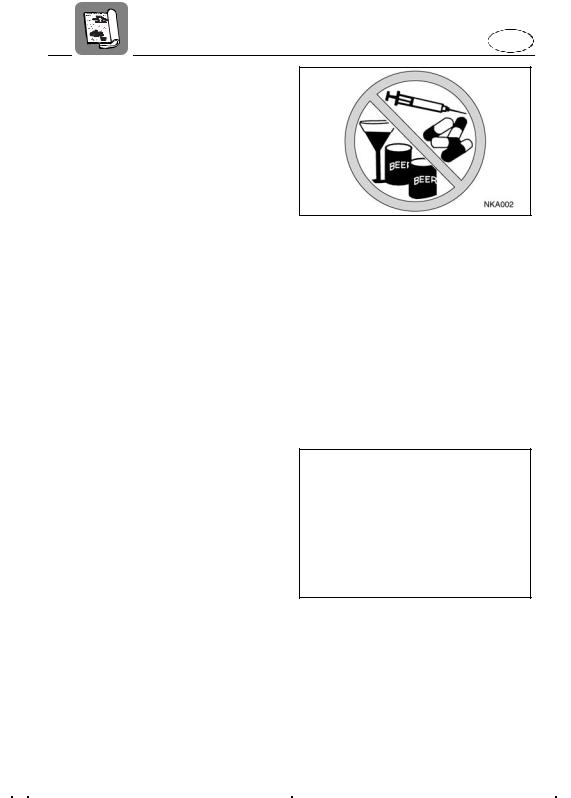
E
●Helmets meeting Snell or DOT standards are required for IJSBA-sanctioned races. You must decide whether to wear a helmet while you ride for recreation. You should know that a helmet could help protect you in certain kinds of accidents and that it could also injure you in others.
A helmet is designed to provide some head protection. Although helmets cannot protect against all foreseeable impacts, a helmet might reduce your injuries in a collision with a boat or other obstacle.
A helmet may have potential safety hazards, as well. Falling into the water could risk the chance of the helmet catching water, commonly known as “bucketing,” and the resulting strain on your neck could cause choking, severe and permanent neck injuries, or death. A helmet could also increase the risk of an accident if it reduces your vision or hearing, or if it distracts you or increases your fatigue. How should you decide if a helmet’s potential safety benefits outweigh its potential risks for you? Consider your particular riding conditions. Consider factors such as your riding environment, your riding style and your riding ability. Also consider the likelihood of traffic congestion, and the water surface conditions. If you decide to wear a helmet based upon your riding circumstances, choose one carefully. Look for a helmet designed for personal watercraft use, if possible. Consider a helmet meeting Snell or DOT standards. If you will be engaging in closedcourse competition, follow the helmet requirements of the sanctioning organization.
●NEVER operate the watercraft after consuming alcohol or taking other drugs.
●For reasons of safety and proper care of the watercraft, always perform the preoperation checks listed on page 3-5 before operating the watercraft.
●The operator and passengers should always keep both feet in the footwell when the watercraft is in motion. Lifting your feet increases your chances of losing your balance, and your feet being hit by objects outside the watercraft. Do not give a ride to children if their feet cannot reach the floor of the footwell.
●Passengers should firmly hold on to the person in front of them.
●Always consult your doctor on whether it is safe for you to ride this watercraft if you are pregnant or in poor health.
1-11
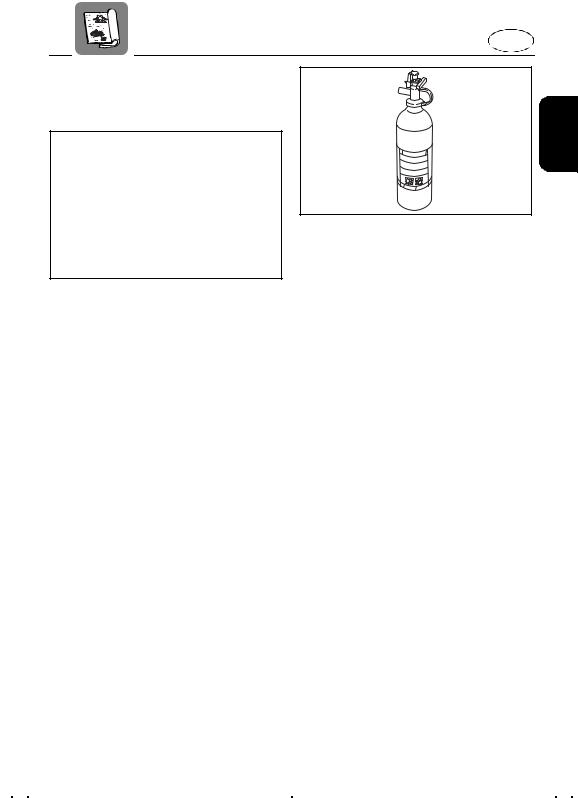
E
● Do not attempt to modify this watercraft! Modifications to your watercraft may reduce safety and reliability, and render the watercraft unsafe or illegal for use.
F0P03010
●Attach the engine shut-off cord (lanyard) to wrist and keep it free from the handlebars so that the engine stops if the operator falls off. After riding, remove the engine shut-off cord from the watercraft to avoid accidental starting or unauthorized use by children or others.
●Scan carefully for swimmers and stay away from swimming areas. Swimmers are hard to see and you could accidentally hit someone in the water.
●Avoid being hit by another boat! You should always take the responsibility to watch for traffic; other boaters may not be watching for you. If they do not see you, or you maneuver more quickly than other boaters expect, you risk a collision.
●Maintain a safe distance from other boats or watercraft, and also watch for boats’ ski ropes or fishing lines. Obey the “Rules of the Road,” and be sure to check behind you before making a turn. (See Rules of the Road on pages 1-16 to 1-19.)
●This watercraft is included in the Class A inboard boat classification of the U.S. Coast Guard. A watercraft of this type MUST carry a fire extinguisher of a B-1 classification, with a capacity of two pounds or more when navigating in waters under Coast Guard jurisdiction. In addition, most state and local boating laws also require that the fire extinguisher be approved by the USCG.
1-12

E
EJU00313
Hazard information
●When transporting or storing your watercraft, always place the fuel cock knob in the “OFF” position, otherwise gasoline may overflow from the carburetor.
●Never start the engine or let it run for any length of time in an enclosed area. Exhaust fumes contain carbon monoxide, a colorless, odorless gas that may cause loss of consciousness and death within a short time. Always operate the watercraft in an open area.
EJU00315a
Watercraft characteristics
●Jet thrust turns the watercraft. Releasing the throttle completely produces only minimum thrust. If you are traveling at speeds above trolling, you will have rapidly decreasing ability to steer without throttle. You may still have some turning ability immediately after releasing the throttle, but once the engine slows down, the watercraft will no longer respond to handlebar input until you open the throttle again or you reach a trolling speed. Practice turning in an open area without obstructions until you have a good feel for this maneuver.
●This watercraft is water-jet propelled. The jet pump is directly connected to the engine. This means that jet thrust will produce some movement whenever the engine is running. There is no “neutral” position.
1-13
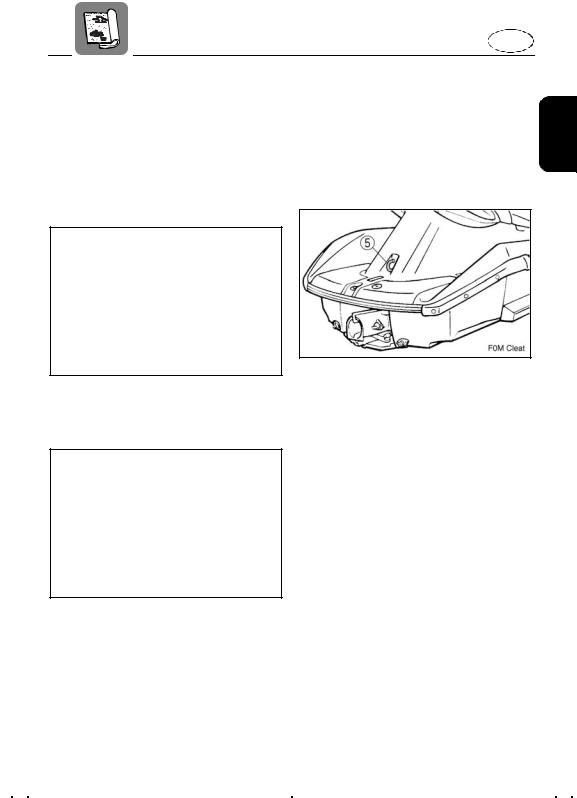
E
●Keep away from intake grate 1 while the engine is on. Items such as long hair, loose clothing, or PFD straps can become entangled in moving parts resulting in severe injury or drowning.
●Never insert any object into the jet thrust nozzle 2 while the engine is running. Severe injury or death could result from coming in contact with the rotating parts of the jet pump.
●Stop the engine and remove the clip 3 from the engine shut-off switch 4 before removing any debris or weeds, which may have collected around the jet intake.
EJU00668a
Water-skiing
You can use the watercraft for water-ski- ing if it has the seating capacity to carry the operator, a rearward-facing spotter, and the water-skier when he or she is not skiing.
The watercraft must also have a cleat 5 designed to pull a ski tow rope; do not attach the tow rope to any other location.
It is the watercraft operator’s responsibility to be alert to the safety of the water-skier and others. Know and follow all state and local water-skiing regulations in effect for the waters in which you will be operating.
The operator should be comfortable carrying passengers before attempting to pull a skier.
The following are some important considerations for minimizing risks while water-ski- ing.
●The skier should wear an approved PFD, preferably a brightly colored one so boat operators can see the skier.
●The skier should wear protective clothing. Severe internal injuries can occur if water is forced into body cavities as a result of falling into the water. Normal swimwear does not adequately protect against forceful water entry into rectum or vagina. The skier should wear a wetsuit bottom or clothing that provides equivalent protection.
1-14
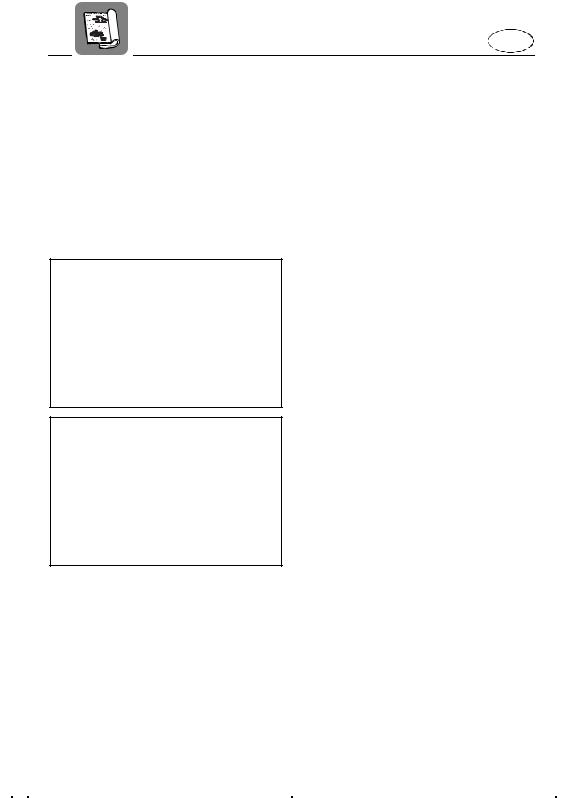
E
●A second person should be on board as a spotter to watch the skier; in most states it is required by law. Let the skier direct the operator’s control of speed and direction with hand signals.
The spotter should sit securely on the passenger seat and hold onto the handgrip 1 with one hand and the finger grip 2 with the other hand, and place his/her feet firmly on the footrest 3 for proper balance while facing to the rear to watch the skier’s hand signals and his or her condition.
●When preparing to pull a skier, operate the watercraft at the slowest possible speed until the watercraft is well away from the skier and slack in the towrope is taken up. Make sure that the rope is not looped around anything.
After checking that the skier is ready and that there is no traffic or other obstacles, apply enough throttle to raise the skier.
●Make smooth, wide turns. The watercraft is capable of very sharp turns, which could exceed the abilities of the skier. Keep the skier at least 50 m (150 ft), about twice the distance of a standard towrope, from any potential hazard.
●Be alert to the hazard of the towrope handle snapping back at the watercraft when the skier falls or is unable to get up on the skis.
●Towing heavy or bulky objects other than skiers, such as another boat or watercraft, can cause loss of steering control and create a hazardous condition. If you must tow another boat in an emergency situation, operate slowly and cautiously.
●Your control while pulling a skier is affected by the skier’s ability, as well as water and weather conditions.
1-15

|
|
|
E |
|
|
|
|
|
|
|
|
|
Steering and sailing rules |
|
EJU00319 |
||||
|
Rules of the Road |
Whenever two vessels on the water meet |
||
|
|
|
||
Yamaha watercraft is legally consid- |
one another, one vessel has the right-of- |
|||
ered a powerboat. |
way; it is called the “stand-on” vessel. The |
|||
Operation of the watercraft must be in |
vessel that does not have the right-of-way is |
|||
accordance with the rules and regula- |
called the “give-way” or “burdened” vessel. |
|||
tions governing the waterway on which it |
These rules determine which vessel has the |
|||
is used. |
right-of-way, and what each vessel should |
|||
Just as there are rules that apply when |
do. |
|||
you are driving on streets and highways, |
Stand-on vessel |
|||
there are waterway rules that apply when |
||||
you are operating your watercraft. These |
The vessel with the right-of-way has the |
|||
rules are used internationally, and are also |
duty to continue its course and speed, |
|||
enforced by the United States Coast Guard |
except to avoid an immediate collision. |
|||
and local agencies. You should be aware of |
When you maintain your direction and |
|||
these rules, and follow them whenever you |
speed, the other vessel will be able to deter- |
|||
encounter another vessel on the water. |
mine how best to avoid you. |
|||
Several sets of rules prevail according to |
Give-way vessel |
|||
geographic location, but are all basically the |
||||
same as the International Rules of the |
The vessel which does not have the right- |
|||
Road. The rules presented here in this |
of-way has the duty to take positive and |
|||
Owner’s/Operator’s Manual are condensed, |
timely action to stay out of the way of the |
|||
and have been provided for your conve- |
stand-on vessel. Normally, you should not |
|||
nience only. Consult your local U.S. Coast |
cross in front of the vessel with the right-of- |
|||
Guard Auxiliary or Department of Motor |
way. You should slow down or change direc- |
|||
Vehicles for a complete set of rules govern- |
tions briefly and pass behind the other ves- |
|||
ing the waters in which you will be operating |
sel. You should always move in such a way |
|||
your watercraft. |
that the operator of the other vessel can see |
|||
|
|
|
what you are doing. |
|
|
|
|
The General Prudential Rule regarding |
|
|
|
|
the right-of-way is that if a collision appears |
|
|
|
|
unavoidable, neither boat has the right-of- |
|
|
|
|
way. Both boats must avoid the collision. |
|
|
|
|
In other words, follow the standard rules |
|
|
|
|
except when a collision will occur unless |
|
|
|
|
both vessels try to avoid each other. If that is |
|
|
|
|
the case, both vessels become give-way |
|
|
|
|
vessels. |
|
1-16

E
Rules when encountering |
|
|
Meeting |
||
vessels |
|
|
If you are meeting another power vessel |
||
|
|
head on, and are close enough to run the risk |
|||
There are three main situations that you |
|||||
of collision, neither of you has the right-of- |
|||||
may encounter with other vessels which |
|||||
way! Both of you should alter course to avoid |
|||||
could lead to a collision unless the Steering |
|||||
an accident. You should keep the other ves- |
|||||
Rules are followed: |
|
|
|||
|
|
sel on your port (left) side. This rule does not |
|||
Meeting: you are approaching another |
|||||
apply if both of you will clear one another if |
|||||
vessel head-on |
|
|
|||
|
|
you continue on your set course and speed. |
|||
Crossing: you are traveling |
across |
||||
|
|
||||
another vessel’s path |
|
|
|
|
|
Overtaking: you are passing or being |
|
|
|||
passed by another vessel |
|
|
|
|
|
In the following illustration, your watercraft |
|
|
|||
is in the center. You should give the right-of- |
|
|
|||
way to any vessels shown in the white area |
|
|
|||
(you are the give-way vessel). Any vessels |
|
|
|||
in the shaded area must yield to you (they |
|
|
|||
are the give-way vessels). Both you and the |
|
|
|||
meeting vessel must alter course to avoid |
Crossing |
||||
each other. |
|
|
|||
|
|
When two power-driven vessels are |
|||
|
|
|
|||
|
|
|
crossing each other’s path close enough to |
||
|
|
|
run the risk of collision, the vessel which has |
||
|
|
|
the other on the starboard (right) side must |
||
|
|
|
keep out of the way of the other. If the other |
||
|
|
|
vessel is on your starboard (right) side, you |
||
|
|
|
must keep out of its way; you are the give- |
||
|
|
|
way vessel. If the other vessel is on your |
||
|
|
|
port (left) side, remember that you should |
||
|
|
|
maintain course and direction, provided the |
||
|
|
|
other vessel gives you the right-of-way as it |
||
|
|
|
|||
|
|
|
should. |
||
|
|
|
|
|
|
|
|
|
|
|
|
1-17

|
|
|
|
|
|
E |
||
|
|
|
|
|
||||
|
|
|
|
|||||
Overtaking |
Sailing vessel right-of-way |
|||||||
If you are passing another vessel, you are |
Sailing vessels should normally be given |
|||||||
the give-way vessel. This means that the |
the right-of-way. The exceptions to this are: |
|||||||
other vessel is expected to maintain its |
1. When the sailing vessel is overtaking the |
|||||||
course and speed. You must stay out of its |
power-driven vessel, the power-driven |
|||||||
way until you are clear of it. Likewise, if |
vessel has the right-of-way. |
|
|
|||||
another vessel is passing you, you should |
2. Sailing vessels should keep clear of any |
|||||||
maintain your speed and direction so that |
fishing vessel. |
|
|
|
||||
the other vessel can steer itself around you. |
3. In a narrow channel, a sailing vessel |
|||||||
|
|
|
should not hamper the safe passage of a |
|||||
Other special situations |
power-driven vessel that can navigate |
|||||||
There are three other rules you should be |
only in such a channel. |
|
|
|||||
|
|
|
|
|
||||
aware of when riding your watercraft around |
Reading buoys and other |
|||||||
other vessels. |
||||||||
Narrow channels and bends |
markers |
|
|
|
||||
The |
waters of |
the United |
States are |
|||||
When navigating in narrow channels, you |
marked |
for safe |
navigation by |
the lateral |
||||
should keep to the right when it is safe and |
||||||||
system of buoyage. Simply put, buoys and |
||||||||
practical to do so. If the operator of a power- |
||||||||
markers have an arrangement of shapes, |
||||||||
driven vessel is preparing to go around a |
||||||||
colors, numbers and lights to show which |
||||||||
bend that may obstruct the view of other |
||||||||
side of the buoy a boater should pass on |
||||||||
water vessels, the operator should sound a |
||||||||
when navigating |
in a particular direction. |
|||||||
prolonged blast of four to six seconds on the |
||||||||
The markings on these buoys are oriented |
||||||||
whistle. If another vessel is around the bend, |
||||||||
from the perspective of being entered from |
||||||||
it too should sound the whistle. Even if no |
||||||||
seaward (the boater is going towards the |
||||||||
reply is heard, however, the vessel should |
||||||||
harbor). Red buoys are passed on your star- |
||||||||
still proceed around the bend with caution. If |
||||||||
board (right) side when proceeding from |
||||||||
you navigate such waters with your water- |
||||||||
open water into the harbor, and black buoys |
||||||||
craft, you will need to carry a portable air |
||||||||
are to your port (left) side. An easy way to |
||||||||
horn, available from local marine supply |
||||||||
remember the meaning of the colors is the |
||||||||
stores. |
||||||||
phrase “red right returning.” When navigat- |
||||||||
|
|
|
||||||
Fishing vessel right-of-way |
ing out of the harbor, your position with |
|||||||
respect to the buoys should be reversed; red |
||||||||
All vessels fishing with nets, lines or |
buoys should be to port and black buoys to |
|||||||
trawls are considered to be “fishing vessels” |
||||||||
starboard. |
|
|
|
|||||
under the International Rules. Vessels with |
Many bodies of water used by boaters are |
|||||||
|
|
|
||||||
trolling lines are not considered fishing ves- |
entirely within the boundaries of a particular |
|
sels. Fishing vessels have the right-of-way |
||
state. The Uniform State Waterway Marking |
||
regardless of position. Fishing vessels can- |
||
System has been devised for these waters. |
||
not, however, impede the passage of other |
||
|
||
vessels in narrow channels. |
|
|
1-18 |
||

E
This system uses buoys and signs with distinctive shapes and colors to show regulatory or advisory information. These markers are white with black letters and orange borders. They signify speed zones, restricted areas, danger areas, and general information.
Remember, markings may vary by geographic location. Always consult local boating authorities before riding your watercraft in unfamiliar waters.
1-19

E
EJU00320
To get more boating safety information
Be informed about boating safety. Additional publications and information can be obtained from many organizations, including the following.
United States Coast Guard
Consumer Affairs Staff (G-BC)
Office of Boating, Public, and Consumer
Affairs
U.S. Coast Guard Headquarters
Washington, D.C. 20593-0001
Boating Safety Hotline: 1-800-368-5647
Yamaha is the watercraft industry’s leading manufacturer to build awareness and support for boating education. In 1997, Yamaha launched its GET W.E.T. (Watercraft Education and Training) initiative and has since reached out to over one million Americans promoting the benefits of boating education.
The Online Boating Safety Course:
http://www.boatus.com/onlinecourse/
Other sources
You can find local rules by contacting the National Association of State Boating Law Administrators, or your local Power Squadron.
Watercraft Education and
Training
The Online Boating Safety Course, available through the watercraft section of the yamaha-motor.com website, is a free, 50 question learning course available to the public. Upon successful completion of 80 percent or better, the user can request a certificate of completion by mail or can download one immediately. The Online Boating Safety Course, provided by the Boat/US Foundation, is approved by the National Association of State Boating Law Administrators (NASBLA) and recognized by the United States Coast Guard. This course meets the education requirement for those states that recognize non-proctored, NASBLA-approved courses.
1-20

E
EJU00322
Enjoy your watercraft responsibly
You share the areas you enjoy when riding your watercraft with others and with nature. So your enjoyment includes a responsibility to treat these other people, and the lands, waters, and wildlife with respect and courtesy.
Whenever and wherever you ride, think of yourself as the guest of those around you. Remember, for example, that the sound of your watercraft may be music to you, but it could be just noise to others. And the exciting splash of your wake can make waves others won’t enjoy. Avoid riding close to shoreline homes and waterfowl nesting areas or other wildlife areas, and keep a respectful distance from fishermen, other boats, swimmers, and populated beaches. When travel in areas like these is unavoidable, ride slowly and obey all laws.
Remember that pollution can be harmful to the environment. Do not refuel or add oil where a spill could cause damage to nature. Remove your watercraft from the water and move it away from the shoreline before refueling. And keep your surroundings pleasant for the people and wildlife that share the waterways: don’t litter!
When you ride responsibly, with respect and courtesy for others, you help ensure that our waterways stay open for the enjoyment of a variety of recreational opportunities.
1-21

E
EJU00326
FEATURES AND
FUNCTIONS
Location of main components ............... |
2-1 |
|
Operation of controls and other |
|
|
functions.................................................... |
2-4 |
2 |
Rear seat................................................. |
2-4 |
|
Front seat ................................................ |
2-5 |
|
Hood........................................................ |
2-6 |
|
Fuel tank filler cap................................... |
2-6 |
|
Oil tank filler cap...................................... |
2-6 |
|
Fuel cock knob........................................ |
2-7 |
|
Engine stop switch.................................. |
2-8 |
|
Engine shut-off switch............................. |
2-8 |
|
Choke knob............................................. |
2-8 |
|
Throttle lever ........................................... |
2-9 |
|
Start switch.............................................. |
2-9 |
|
Cooling water pilot outlet ...................... |
2-10 |
|
Steering system .................................... |
2-10 |
|
Engine overheat warning system......... |
2-11 |
|
Handgrip................................................ |
2-12 |
|
Oil level warning lamp........................... |
2-12 |
|
Storage compartments ......................... |
2-13 |
|

E
EJU00327
Location of main components
1Cooling water pilot outlet
Use to verify cooling water flow.
2Bow eye
Use to attach rope for transporting, mooring or towing the watercraft in an emergency.
3 Front storage compartment
4 Hood
5 Fuel cock knob
Use to select either normal or reserve fuel flow from the fuel tank to the carburetors, or to shut off fuel flow.
6 Handlebars
Use to control direction.
7 Fuel tank filler cap
8Rope hole
Use to attach a rope for mooring only.
9 Oil tank filler cap
0Choke knob
Use to start a cold engine.
AFootwell
Use to place feet for balance.
B Footrest
CFire extinguisher container
Use to store the fire extinguisher.
D Intake grate
Prevents debris from getting into the jet pump.
EHandgrip
Use for support when boarding the watercraft or when seated facing rearward and acting as a spotter for a water-skier.
F Rear seat
G Front seat
H Glove compartment
I Seat storage compartments
2-1
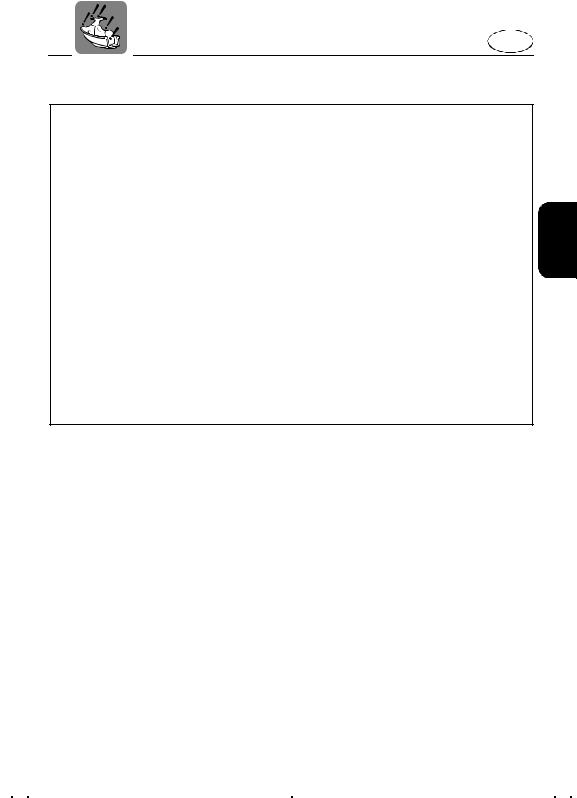
E
1 |
Engine shut-off cord (lanyard) |
6 |
Oil level warning lamp |
|
Attach to wrist so that the engine stops if the |
7 |
Throttle lever |
|
operator falls off the watercraft. |
|
Use to accelerate and decelerate. |
2 |
Engine stop switch |
8 |
Stern drain plugs |
|
Push to stop the engine normally. |
|
Use to drain water in the bilge when the water- |
3 |
Clip |
|
craft is on dry land. |
|
Insert into the engine shut-off switch to enable |
9 |
Jet thrust nozzle |
|
starting of the engine. |
|
Changes the direction of jet thrust according |
|
Remove to stop the engine or prevent acci- |
|
to handlebar position. |
|
dental starting of the engine or unauthorized |
0 |
Cleat |
|
use of the watercraft. |
|
Use to attach a towrope for pulling water-skier |
4 |
Engine shut-off switch |
|
or a rope mooring the watercraft. |
|
Remove the clip to stop the engine and dis- |
A Ride plate |
|
|
able it from starting. |
|
|
5Start switch
Push to start the engine.
2-2
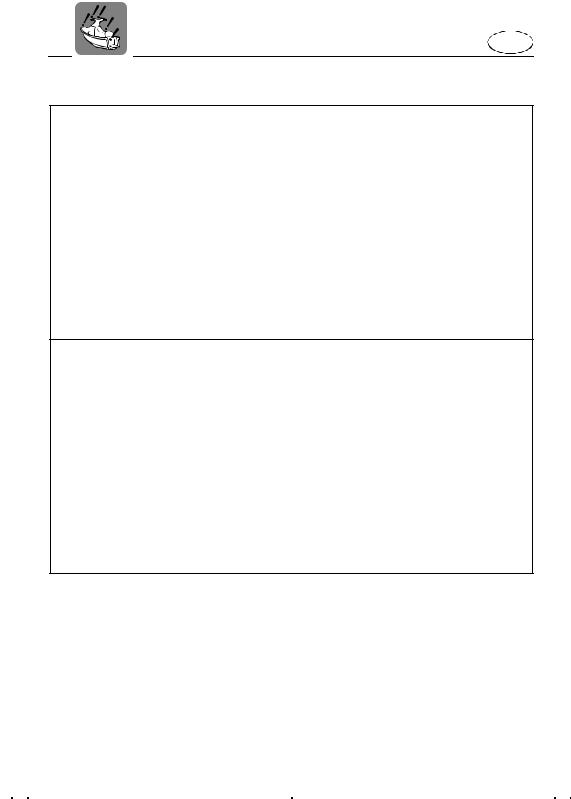
E
1 |
Silencer |
6 |
Fuel tank |
|
Prevents water from getting into the engine |
7 |
Oil tank |
|
and reduces air intake noise. |
8 |
Fuel filter |
2 |
Spark plugs/caps |
9 |
Flush hose connector |
3 |
Electrical box |
|
Use to flush the engine cooling water pas- |
|
Protects electrical components from water. |
|
sages. |
4 |
Spark plug lead |
0 |
Battery |
5 |
Muffler |
|
|
2-3
